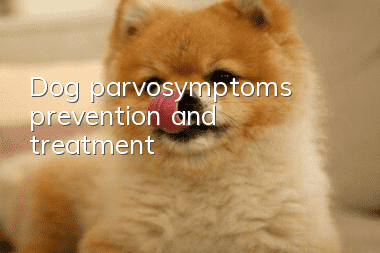Dog parvosymptoms, prevention and treatment

Canine parvovirus is one of the three major infectious diseases of dogs. It is undoubtedly a nightmare for dogs, especially puppies, to be infected. It has the characteristics of high contagiousness, high mortality, and great physical harm. Therefore, it is best for us to do a good job in preventing this disease and try our best to prevent dogs from being infected with this virus.
American Foxhound
1. Dogs have symptoms of parvovirus
Parvovirus is one of the most serious infectious diseases that harms dogs today. It is commonly known as intestinal turning because the main symptom of parvovirus is that it damages the digestive system. Unlike enteritis, the symptoms of parvovirus are more serious and the mortality rate is high. .
Parvovirus can be prevented by vaccination. In theory, the incidence rate of vaccinated dogs is extremely low, but for dogs under three months old or dogs that have not been vaccinated on time , the possibility of tiny occurrences is greatly increased. Below is a detailed introduction to the symptoms of parvovirus in dogs.
In the early stage, the sick dog was depressed, anorexic, occasionally had fever, soft stools or mild vomiting, and then developed into frequent vomiting and severe diarrhea. At first, the feces will be gray, yellow or milky white with jelly-like mucus, and then there will be foul-smelling soy sauce or tomato juice-like bloody stools. The sick dog suffered rapid dehydration, weight loss, sunken eye sockets, messy coat, inelastic skin, cold ears, nose, and limbs, severe depression, shock, and death.
We will find that the early symptoms of parvovirus are very similar to the symptoms of dog colds, so how can we distinguish the two diseases based on their symptoms?
First of all, when a dog has a cold, it usually means that the dog is sluggish, loves to sleep, and cannot be energetic about toys and delicious food. The body feels warmer than before, the eyes are red, the nose is runny, the breathing is accelerated, etc. In fact, the symptoms are basically the same as those of a cold and a fever.
In addition to the symptoms similar to colds mentioned above, the most important symptoms of parvovirus are gastrointestinal symptoms. Diarrhea and vomiting are the most obvious symptoms, and they will become more and more serious, with vomiting and bloody diarrhea appearing. It is worth mentioning that parvovirus is easy to distinguish in animal hospitals. There are corresponding test strips or blood tests, and the diagnosis can be confirmed with just one examination. So if you suspect that your dog is not suffering from a simple cold, go and get it as soon as possible. Going to the hospital for a check-up is the most practical and reassuring thing to do.
2. How to treat canine parvovirus
Canine parvovirus disease is an acute infectious disease in dogs caused by canine parvovirus infection. Its clinical manifestations include type 2, namely enteritis type and myocarditis type. The enteritis type is more common and has four main characteristics: ① The body temperature rises at the beginning of the disease, reaching 40-41°C; ② Vomiting first, then diarrhea, and the stool is yellow or gray-yellow at first, and then turns to tomatoJuice-like, fishy smell, especially unpleasant; ③ After vomiting and diarrhea, obvious symptoms of dehydration will appear, such as weakness, weight loss, depression, sunken eyeballs, and reduced skin elasticity; ④ In the later stage, the anus will relax, blood in the stool, falling to the ground, coma, and body temperature If the temperature drops below 37°C, death may occur due to electrolyte imbalance and acidosis. From the breed point of view, this disease mainly occurs in small dog breeds, and foreign dog breeds are more common, and local breed dogs and large dogs are rare; from the age of onset, this disease mostly occurs in puppies under 5 months old, and in adult dogs Rarely occurs; from a seasonal perspective, it occurs more frequently from February to June and is less common in other seasons.
There is no specific drug for the treatment of canine parvovirus enteritis. Comprehensive treatment measures should be adopted clinically. The commonly used methods are: symptomatic therapy + supportive therapy + specific therapy + traditional Chinese medicine therapy.
1. Symptomatic therapy
The main characteristics of canine parvovirus enteritis are vomiting, diarrhea, and bloody stools. Symptomatic treatment should focus on these three keys. Drugs such as Amor, metoclopramide, VB6, atropine, and chlorpromazine can be used to prevent vomiting. In clinical practice, intramuscular injection of Amor should be preferred, and atropine should be used if necessary. Metoclopramide should not be used in patients with gastrointestinal bleeding. For antidiarrheal, tannic acid protein and Shimida can be used. Because the sick dog is vomiting, it is not suitable to give it orally. It is best to use a deep enema. In order to prevent and treat intestinal bleeding, epinephrine, benzoic acid, annexamic acid, anluoxue, hemostasis, VK3, and VK1 can be used. If the effect of intramuscular injection is not satisfactory, it can be combined with intramuscular injection or intravenous drip of hemostasis and sodium carbosulfonate.
2. Supportive therapy
The main function of supportive therapy is to maintain heart function, regulate acid-base balance, and restore body condition as soon as possible. The most commonly used method is cardiac rehydration. For infusion, 0.9% sodium chloride solution, Ringer's solution, and 5% sugar saline solution can be used. When used for puppies under 4 months of age, the input amount of glucose solution should be increased. Infusion should be given at least once a day. For those with mild vomiting, you can use oral rehydration salts to drink by yourself: 3.5g sodium chloride, 1.5g potassium chloride, 2.5g sodium bicarbonate, 20g glucose, and add water to 1000mL.
During infusion, attention should be paid to potassium, calcium, and sodium bicarbonate supplements.
Anyone who fasts for more than 3 days should supplement potassium. The dosage is 0.1 to 0.2g per kilogram of body weight per day, divided into 2 to 3 times. When supplementing potassium alone, the concentration should not exceed 3%; if the concentration is too high, you can Dilute with 5% to 10% glucose solution.
Calcium supplementation can often prevent hypocalcemia convulsions. 10% calcium gluconate solution can be intravenously dripped at a dose of 1 to 2 mg/kg.
Supplementing sodium bicarbonate solution can prevent acidosis. You can use 5% sodium bicarbonate solution at a dosage of 5mL/kg body weight. Dilute it with 2 times the amount of 5% glucose or 10% glucose solution to make it an isotonic solution, and then intravenously Instillation.
In order to protect the liver and strengthen the heart, 20 to 40 mg of ATP and 100 to 200 IU of acetyl CoA should be added to the intravenous injection, or 10% calcium gluconate solution should be injected intravenously alone.
3. Specific therapy
Canine parvovirus enteritis is a viral disease and there is no specific treatment drug. Clinically, ampicillin (15-20 mg/kg), gentamicin (20,000-80,000 IU), dexamethasone (2-20 mg), Gentamicin (40,000 IU), norfloxacin, etc. If the diagnosis is accurate and timely, in the early stage of the disease, the use of specific products such as hyperimmune serum, parvovirus monoclonal antibodies, interferon, immunoglobulin, and canine life source will be more effective.
4. Traditional Chinese Medicine Therapy
Recipe 1: Coptis 20g, Phellodendron 30g, Scutellaria baicalensis 50g, Acosta 35g, White peony root 40g, Pueraria lobata 20g, Sanguisorba 30g, Radix isatidis 40g, Curcuma longum 30g, Gardenia 20g, Senecio 30g, Thistle 25g, Thistle 25g, Licorice 15g. Decoction in water, 3 times a day, 1 dose every 2 days; when vomiting is severe, deep rectal administration can be selected.
Recipe 2: Turmeric 15g, Pulsatilla 20g, Coptis 10g, Phellodendron 10g, Scutellaria baicalensis 10g, White Peony 10g, Myrobalan 15g, Licorice 20g. Decoction in water, take 1 dose per day, take 3 to 5 doses. Reduced for puppies.
3. Preventive measures against canine parvovirus
Canine Parvovirus (CPV), abbreviated as CPV, is a disease with a relatively high fatality rate for dogs. This virus is still prevalent all over the world and is also one of the major serious infectious diseases that harms dogs. To prevent canine parvovirus, vaccination and disinfection are very important.
CPV has strong resistance to the outside world and has a long survival time, so it is extremely contagious. Once the disease occurs, the sick dog should be quickly isolated, and the kennel feeding equipment, utensils, and transportation vehicles contaminated by the sick dog should be strictly disinfected. The disinfectant can be 2% NaOH, bleaching powder, potassium hypochlorite, etc. Ultraviolet irradiation can be used for repeated disinfection. and stop using it for 2 weeks. Breeders should be strictly disinfected and their movement restricted to avoid indirect infection.
Vaccine immunization is the fundamental measure to prevent disease. However, immune failure may occur, which is related to vaccine quality and immune interference. The main reasons are improper selection of vaccine strains and interference from maternal antibodies. Vaccines should be of reliable quality. The first vaccination time is generally considered to be around 10 weeks of age. However, considering that puppies are also susceptible before 10 weeks of age, the two-part puppy vaccine (this vaccine) can generally be injected at 6 weeks of age. (can break through the interference of maternal antibodies), inject the six-link vaccine at 10 weeks of age, and then inject the six-link vaccine every 3 weeks for 2-3 times in a row.Immunize once a year.
- Why do dogs bite their own tails?
- What are the reasons why dogs sneeze? Don’t be careless!
- Why doesn’t a dog urinate?
- Why is my puppy's hind legs shaking?
- What is the best age to train a Border Collie? Border Collie training tips!
- What should dogs pay attention to in each season of the year?
- How to train a dog not to wet the bed? Analysis of the reasons why dogs wet the bed!
- Symptoms and treatment of gastritis in dogs
- Can dogs eat isatis roots if they have a cold and runny nose? Dog owners should pay attention!
- What are the benefits of raising a dog? There are these benefits of raising a dog!



